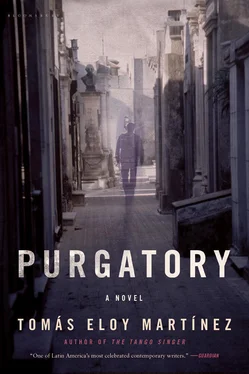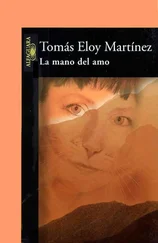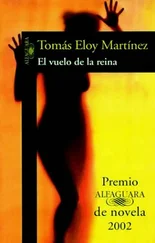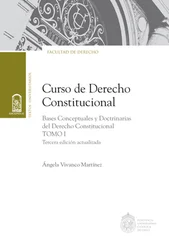In another of the photos, Emilia is greeting an actress who appeared in a number of Torre Nilsson’s early films and who, for years, had vanished off the face of the earth. The woman looks frightened, as though she has just been caught doing something terrible and wants to hide away. Until twenty years ago, the newspapers carried on publishing stories about what had happened to her, all of them false. Once she was dead, they lost interest and she fell into oblivion. Sometimes I see the startled expression of that former actress staring back at me from a poster in the film club, always the same face, eyes gazing into the middle distance, lips twisted in a foolish smile. Emilia mentioned her in passing that morning we went to see Mary Ellis’s grave. She told me that Torre Nilsson had taken her and turned her into a unique character, terrified of sex, constantly afraid of being raped. Later, other directors took advantage of her naive defenceless image to transform her into the perfect victim: a teenage girl who has her virginity taken in a brothel, a country girl who swears eternal love to a rogue in an empty church convinced that, though there are no witnesses, this oath is enough for them to be legally married. Going from one melodrama to the next confused her. One day she woke up not knowing who she really was and ran off the set of her last film. She got on the first bus she saw and disappeared without a trace. She never told anyone what happened in the months that followed. She had no family, only a neighbour she occasionally went out with for pizza. Maybe she was living in a hotel in a small town, maybe she ran away to the beach because when she came back she was very tanned. No producer every called her again. She went back to her old house, to her old routine of going out for pizza with her neighbour and became a dressmaker. Ever since she was a girl she had liked drawing dresses, cutting out patterns, embroidering, making costumes for her dolls. She opened a small shop, took in two stray cats and never spoke about the past again. She emerged from her obscurity only to say goodbye to the director who had discovered her and changed her life. She had intended only to spend a few minutes in the funeral chapel, to leave a flower, say a prayer. The dead man mattered less to her than that part of her life which had already died. On the huge poster hanging beside the door of the chapel she saw herself, cowering in the shadows of two men. Seeing herself like this, on display, it seemed as though this funeral was hers too and she almost fled. Emilia saw the woman leaving, looking as though she was about to faint, and went to help her. It took a moment before she recognised her. She was no longer the teenage girl in the poster. She was overweight, dishevelled and looked like a middle-class housewife. She had met her long ago in the house on calle Arenales when the actress had come with Torre Nilsson to ask Dupuy to intercede with a reactionary censor who was busy cutting swathes out of the finest films of the day, from Buñuel and Stanley Kubrick to Dreyer and Fellini. Childbirth and kissing, however reverently done, could not be seen anywhere near a church. He had banned two of Torre Nilsson’s films and was threatening to bowdlerise a third. ‘I don’t know what my father said to him,’ Emilia told me. ‘All I remember is that the girl was crying when she left. At the time, she looked like a schoolgirl — she wore a blouse with a big lace collar and ribbons in her hair. She had the same astonished expression she had in her films, as though her body shifted untouched from fantasy to reality. The trembling woman in the funeral chapel was a different person, she was short and fat with a double chin.’ Emilia took pity on her and took her outside for some fresh air. Then she invited her to go for coffee at a cafe on the corner and sat with her until she had calmed down. That was all. Emilia didn’t tell me that it was at that moment the photograph I’m looking at now was taken. The rest of the story I know from the notes and cuttings she left in North 4th Avenue.
The more I delve into Emilia’s life, the more I realise that from beginning to end it is an unbroken chain of losses, disappearances and senseless searches. She spent years chasing after nothing, after people who no longer existed, remembering things that had never happened. But aren’t we all like that? Don’t we all abuse history to leave some trace there of what we once were, a miserable smudge, a tiny flame when we know that even the deepest mark is a bird that will leave on a breath of wind? ‘One human being is more or less the same as another; perhaps we are all already dead without realising it, or not yet born and do not know it,’ I said to Emilia one of the last times I saw her. ‘We come into the world without knowing it, the result of a series of accidents, and we leave it to go who knows where, nowhere probably. If you hadn’t loved Simón you would have loved someone else. You would have done so joyfully, with no guilt, because you cannot love what you do not know.’ She didn’t like this idea because she could not conceive of a world without Simón and loving made sense only if it meant loving him. I don’t think I understood at all that afternoon. Now, I would say I was an optimist, that the mere fact of existing or loving is enough to give meaning to everything. This is not how Emilia feels, and she is right. I realise this when I find a map among the papers that she left: the map of a city that stretches out in time not in space, and maybe because of that, an impossible city. There are transparent edges with dates beneath which the city is always different. In the centre is a vast palace next to a lake or reservoir. Above the palace, in capital letters, is written the code word to her life, Simón. The map is torn, wet with drool and with tears. It has no edges, sectors, bearing, no scale, and I don’t think it is necessary to ask where they are.
I have already spent hours unearthing what is hidden in the folds and on the backs of the photographs and clippings given to me by Nancy Frears. Perhaps there is nothing worthwhile here, perhaps that part of Emilia’s life I do not know is a lunar desert or an insignificant outcrop like Kaffeklubben. I begin reading one of her notebooks. ‘I know D is a dressmaker and I’ve asked her to make me some dresses. ’ The cellphone I always carry with me rings and I set down the notebook. It is noon. Not many people know I have a cellphone and I don’t recognise the number calling. I answer, convinced someone has misdialled and prepared to listen to an apology.
‘It’s me. Emilia,’ says the voice. It’s her.
I’m startled. She has taken me so much by surprise that it takes a moment before I react. I don’t even remember where I thought she was hiding.
‘I’ve been looking for you all over,’ I tell her. ‘Nancy was out of her mind with worry — she called the police. You caused a terrible commotion. Where are you? Can I call you?’
‘A commotion,’ she says. Her voice sounds completely calm. ‘There’s no reason to be worried. I’m fine, I’m better than I’ve ever been.’
‘I’m glad,’ I say. ‘But if the police find you, they’ll pick you up.’
‘I didn’t do anything, I’m free to go wherever I like.’
‘Of course. It’s just that you left without telling anyone. At the police station they asked if you were suicidal, if you’d been depressed. One of the officers thought you might have been kidnapped, that you might even be dead. You took the Altima.’
‘What a waste of time. The people in this town have no idea how to fill the lives they don’t have.’
‘They’re looking for your car,’ I tell her. ‘Sooner or later they’re bound to find you. Can I see you?’
‘That’s why I’m calling, so we can meet up,’ she says.
Читать дальше












